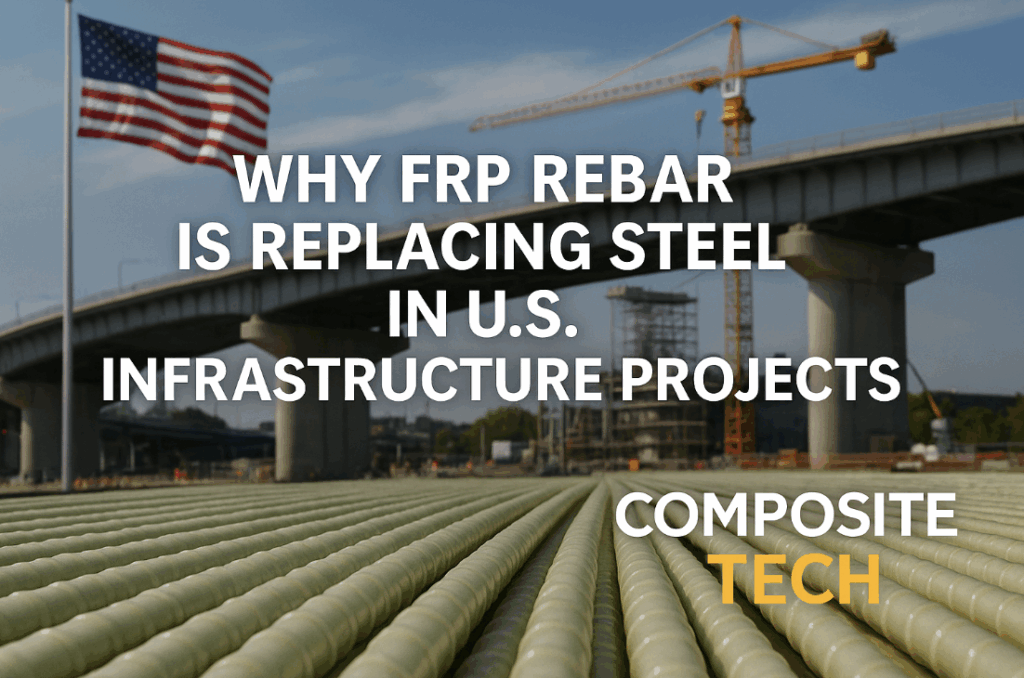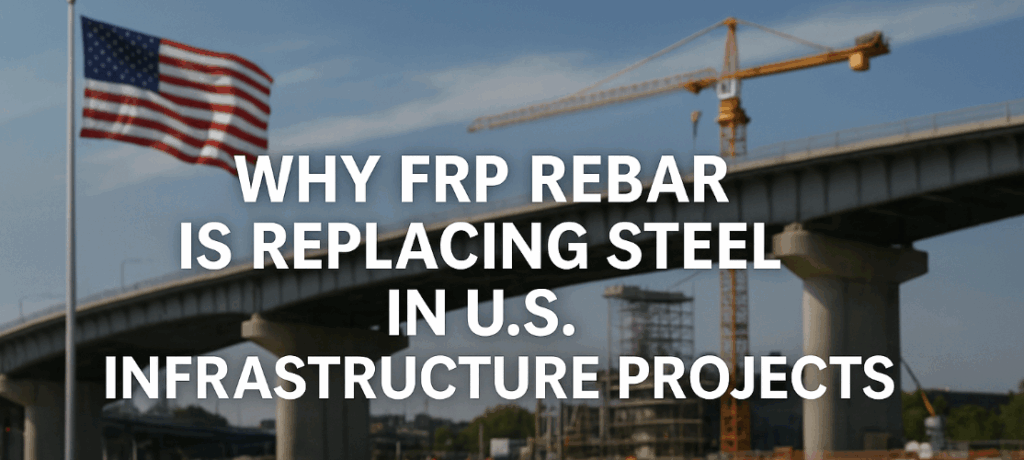O Fim da Era do Aço na Infraestrutura
Por quase 100 anos, as barras de aço dominaram a construção de infraestrutura nos Estados Unidos. De pontes e rodovias a estruturas marítimas e túneis, o aço moldou a América moderna.
Mas o tempo e a ciência revelaram a fraqueza irreversível do aço: a corrosão.

Atualmente, as falhas relacionadas à corrosão custam à economia dos EUA mais de 1,6 trilhão de dólares anualmente, de acordo com a Administração Federal de Rodovias.
A exposição à água salgada, os ciclos de congelamento e descongelamento, os produtos químicos presentes no concreto e as condições ambientais atacam o aço de forma constante, enfraquecendo as estruturas por dentro.
E enquanto os Estados Unidos lançam o maior plano de gastos com infraestrutura da história moderna — mais de 1,2 trilhão de dólares sob a Lei de Investimento em Infraestrutura e Empregos — engenheiros e desenvolvedores se deparam com uma questão crucial:
Por que continuar construindo o futuro com materiais projetados para o passado?
A Ascensão do FRP — Uma Nova Era de Reforço Inteligente
O que é vergalhão de FRP?
A armadura de FRP (Polímero Reforçado com Fibra) — principalmente GFRP (Polímero Reforçado com Fibra de Vidro) — é um reforço composto de alta resistência e à prova de corrosão, projetado para substituir o aço em estruturas de concreto.
Principais vantagens de desempenho
| Propriedade | Aço | Vergalhões de PRFV |
| Resistência à corrosão | Corrói | 100% à prova de corrosão |
| Resistência à tracção | ~60 ksi | 120–200 ksi (2–3 vezes mais forte) |
| Peso | Pesado | 4 vezes mais leve |
| Condutividade térmica | Condutor | Não condutor (seguro contra radiação eletromagnética) |
| Interferência magnética | Sim | Nenhum — seguro para ressonância magnética e radar. |
| Vida útil | 20 a 50 anos | Até 100+ anos |
Resultado: Menos manutenção, maior vida útil, estruturas mais seguras, menor custo total ao longo da vida útil.
Por que os Estados Unidos precisam de FRP agora?
Infraestrutura Costeira e Marinha
Da Flórida à Califórnia, a exposição ao sal destrói o concreto armado com aço.
A fibra de vidro reforçada com plástico (FRP) não enferruja — nunca.
- Pontes costeiras
- Quebra-mares e portos
- Estações de tratamento de águas residuais
- Instalações de dessalinização
Transportes e Pontes
O Departamento de Transportes dos EUA relata Mais de 42.000 pontes com deficiências estruturais.
O PRFV (Plástico Reforçado com Fibra de Vidro) prolonga a vida útil e reduz os custos de reabilitação.
Estruturas Militares e de Defesa Crítica
FRP é não condutor e não magnético — essencial para sistemas de radar, centros de dados e instalações de defesa.
Infraestrutura de energia limpa e veículos elétricos
Usinas de baterias de nova geração, instalações de hidrogênio e centros de energia exigem reforço não corrosivo e não condutor.
Conformidade com as normas de engenharia dos EUA
As barras de reforço de GFRP modernas estão em conformidade com as principais normas dos EUA:
| Padrão | Descrição |
| ACI 440.11-22 | Código de projeto de vergalhões de PRFV |
| ASTM D7957 | Especificação padrão para PRFV (Plástico Reforçado com Fibra de Vidro) |
| Aprovação do FDOT | Para construção na Flórida |
| CSA S806 | Código de projeto norte-americano |
Equipamento Composite-Tech é projetado para fabricar Produtos de FRP que atendem — e superam — essas especificações.
Análise de custos: aço versus PRFV (Plástico Reforçado com Fibra de Vidro)
Conversa tradicional:
“O aço é mais barato por tonelada.”
Realidade moderna:
Custo total ao longo da vida útil > Custo de aquisição.

| Categoria de custo | Aço | PRFV |
| Custo inicial do material | Mais baixo | Um pouco mais alto |
| Instalação | Requer equipamento pesado | Leveza = maior velocidade e menor custo |
| Manutenção | Alto (reparo de corrosão) | Próximo de zero |
| Vida útil | 20 a 50 anos | 80–100+ anos |
| Custo total do ciclo de vida | Alto | Mais baixo |
Conclusão: O FRP se destaca na análise econômica do ciclo de vida — a métrica mais importante para projetos governamentais e grandes desenvolvedores de infraestrutura.
Por que os fabricantes escolhem a Composite-Tech?
A adoção moderna de PRFV (Plástico Reforçado com Fibra de Vidro) nos Estados Unidos não é apenas impulsionada pela demanda — é impulsionado pela tecnologia.
Os equipamentos da Composite-Tech garantem:
- Qualidade em conformidade com ACI/ASTM
- Fabricação automatizada (operação 24 horas por dia, 7 dias por semana)
- Alinhamento preciso da fibra
- Impregnação consistente de resina
- Controle perfeito de cura
- Calibração de diâmetro estável
E o mais importante?
Os parâmetros de produção garantidos foram testados para atender aos padrões dos EUA.
Histórias de sucesso no mundo real
Flórida, EUA — Fábrica de PRFV Costeira
- região de exposição extrema ao sal
- FRP (plástico reforçado com fibra de vidro) é escolhido para substituir o aço na infraestrutura marítima.
- As linhas de produção da Composite-Tech produzem vergalhões de alto volume 24 horas por dia, 7 dias por semana
Índia — Expansão em larga escala de PRFV (Plástico Reforçado com Fibra de Vidro)
- Governo pressiona por infraestrutura resistente à corrosão
- Os sistemas Composite-Tech foram escolhidos pela sua escalabilidade e precisão.
- Atende rodovias, túneis de metrô e projetos industriais.
Engenheiros escolha-nos Não apenas para desempenho, mas também para parcerias, treinamento e suporte a padrões.
Olhando para o futuro — PRFV reforçado com grafeno
A Composite-Tech está aprimorando o GFRP para a próxima geração:
Barra de reforço composta reforçada com grafeno.
Benefícios:
- Aumento da resistência à tração
- Capacidade de preencher fissuras
- Maior durabilidade
- Aplicações emergentes de controle de condutividade
Essa inovação posiciona o FRP como o tecnologia de reforço definitiva para o próximo século da infraestrutura americana.
Conclusão
O aço serviu o mundo durante um século. O PRFV (Plástico Reforçado com Fibra de Vidro) impulsionará o próximo.
Os Estados Unidos estão entrando em uma nova era de infraestrutura — mais inteligente, mais durável e ambientalmente responsável.
O FRP não é apenas um material melhor — é o novo padrão.
Pronto para começar a fabricar vergalhões de PRFV nos Estados Unidos?
A Composite-Tech fornece soluções de produção completas, Suporte para instalação, treinamento e certificação.
Solicite o seu plano de retorno do investimento (ROI) para fábrica de PRFV (Plástico Reforçado com Fibra de Vidro).
Agende uma consulta técnica.
Saber mais:
- Da Flórida à Índia: como as máquinas de tecnologia de compósitos capacitam os líderes globais em PRFV (Plástico Reforçado com Fibra de Vidro).
- Por que a Composite-Tech e o FRP Institute estão definindo os padrões globais para compósitos?
- ACI 440.11-22 Explicado: Como Projetar Concreto com Vergalhões de PRFV nos EUA
- Entendendo a norma ACI 440.11-22 para fabricantes de vergalhões de GFRP
- Grafeno na produção de vergalhões de GFRP: uma revolução no reforço de concreto
- Vergalhão de fibra de vidro #3 (3/8 pol.): preço, peso e casos de uso reais nos EUA
- Por que a Composite-Tech é líder global em equipamentos de produção de GFRP
- Vergalhões de PRFV vs. Aço: Custo, Resistência e Benefícios a Longo Prazo na Construção Moderna
- Vergalhão de GFRP versus vergalhão de aço: uma comparação técnica completa.
- Vergalhões de PRFV vs. Aço: Custo, Resistência e Benefícios a Longo Prazo na Construção Moderna

